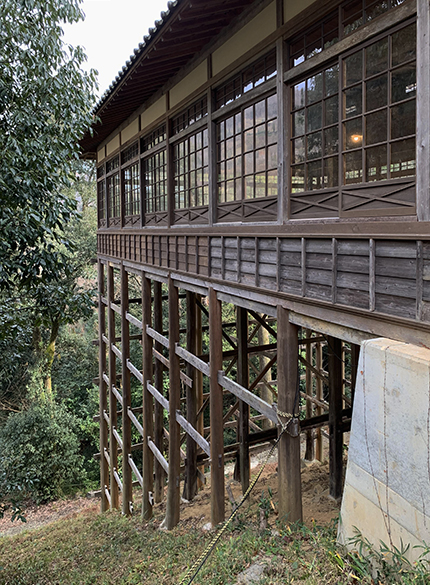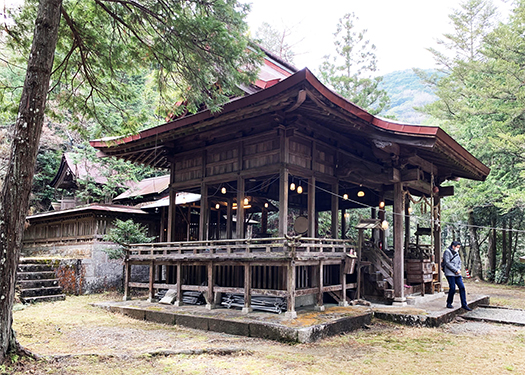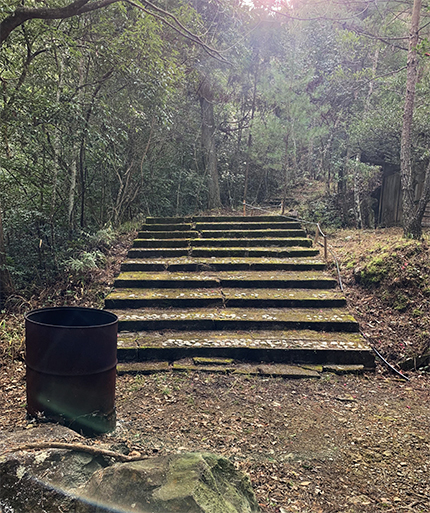

きのうはこの神社の神代の時代について想像を巡らせてみましたが
歴史年代での神社の記録とはWikipediaでは以下のようになっています。
・1441年:(嘉吉1年)宇都宮次郎太郎、少彦名神社へ扁額『少比古廟』奉納
・1583年:(天正11年)正岡宮内大輔、少彦名神社を再興
・1934年:参籠殿建築される。
・2013年:ワールド・モニュメント財団によって2014年版
「危機に瀕している世界のモニュメントリスト」に登録された。
・2014年6月:本格修復始まる。
・2014年6月:棟梁の男性が転落死し、修復中断。
・2014年8月:再発防止策を講じ、修復再開。
・2015年3月:参籠殿本体の修復工事を終え竣工式を行う。
・2016年5月:参籠殿一棟(附 棟札及び板図)が市指定有形文化財に指定。
・2016年9月:参籠殿修復でユネスコアジア太平洋文化遺産保全賞最優秀賞受賞。
写真は参籠殿の足下をクローズアップしたものと拝殿の様子。
たまたま訪問したときにはたくさんの氏子さんたちが参集されていて
わたしたち夫婦も氏子の遠方代表みたいに見られていました(笑)が、
氏子総代のような方からいろいろご説明をいただいた。
さすがに敬神の篤いみなさんと深く納得させられました。
北海道神宮に少彦名命が祀られていることはご存じない方が多かった。
日本全国の神社に祀られるので北海道を特別に見られてはいないのでしょう。
ユネスコから顕彰されたことで地域プライドが上がったと思える。
神社縁起伝承はファンタジーのモヤに包まれるけれど、
それを大切にして敬神し続ける人間の活動は真実なのだと思います。
また痛ましい犠牲者のためにも高い尊崇心は鎮魂でもあるのかも。
多くの参集されたみなさんの思いに深く敬服するところです。

全国津々浦々に神社は建てられているけれど、
この少彦名神社は命がこの地で常世に旅立たれた、すなわちここで死んだ。
そういった神社縁起はきわめて特異なのだそうです。
梁瀬山という標高372mの山体自体が一種の墓域というように見なせる。
鳥居周辺にクルマを停めてから400-500mで参籠殿や拝殿に至るのですが、
そこからさらに階段がしつらえられていて、山頂に至るまで御陵などがある。
旅の途中であり、この階段に深く向かってうやうやしく二礼二拍手一礼して
お詣りとさせていただき、常世での命のご健勝を祈念いたしました。
しかし大国主命と協力して国づくりされ、いまも北海道神宮で
国土づくりの尊霊として民のためにお働きいただいているというファンタジー。
民族のこころのコア部分を見るようで癒されるものを感じさせられる。
こういう民俗は大切にしていくべきと思いを強くした次第です。
English version⬇
[Land construction and the reliance of the people’s hearts Sukunahikona Shrine-3]
Yesterday I imagined the era of the Shinto shrine.
The record of the shrine in the historical age is as follows in Wikipedia.
・ 1441: Utsunomiya Jirotaro dedicates a flat “Shohiko Mausoleum” to Sukunahikona Shrine
・ 1583: Masaoka Miyauchi Daisuke revives Sukunahikona Shrine
・ 1934: Sangoden is built.
2013: 2014 edition by the World Monuments Fund
Registered in the “Monument List of the Endangered World”.
・ June 4, 2014: Full-scale restoration begins.
・ June 11, 2014: A man on the ridge fell to death and repair was suspended.
・ Around August 1, 2014: Measures to prevent recurrence were taken and repairs resumed.
・ March 7, 2015: The completion ceremony will be held after the restoration work of the main body of Sangoden is completed.
・ May 30, 2016: One building of Sangoden (attached building tag and board drawing) is designated as a tangible cultural property designated by the city.
・ September 1, 2016: Received the UNESCO Asia-Pacific Cultural Heritage Conservation Award for Best Restoration.
The photo shows a close-up of the foot of the hall of worship and the state of the hall of worship.
When I happened to visit, many boys and girls were gathered
Our couple were also seen as distant representatives of their sons (laughs),
We received various explanations from people like the president of the school.
As expected, I was deeply convinced by the serious people of Keijin.
Many people did not know that the name of Sukuna bi kona was enshrined in Hokkaido Jingu Shrine.
Since it is enshrined in shrines all over Japan, you probably haven’t seen Hokkaido in particular.
It seems that the regional pride has been raised by being commended by UNESCO.
The tradition of shrine luck is wrapped in a fantasy haze,
I think that the activities of human beings who cherish it and continue to respect it are true.
Also, high reverence may be a requiem for the painful victims.
I deeply admire the thoughts of many people who have gathered.
Although shrines are built all over the country,
This Sukunahikona Shrine died here, that is, the life of the shrine departed to the eternal world here.
It seems that such shrine luck is extremely peculiar.
Yanazeyama, a mountain body with an altitude of 372 m, can be regarded as a kind of grave area.
After stopping the car around the torii gate, it takes 400-500m to reach the shrine and worship hall.
From there, there are stairs, and there are royal tombs up to the summit.
In the middle of the trip, I respectfully go deep into this staircase and give a second bow and a bow
We pray for the good health of life in the everlasting world.
However, the country was created in cooperation with Okuninushi, and it is still at Hokkaido Jingu Shrine.
A fantasy that you are working for the people as a ghost of land creation.
It makes me feel healed by seeing the core part of the heart of the people.
I strongly felt that such folklore should be cherished.
Posted on 1月 15th, 2022 by 三木 奎吾
Filed under: 日本社会・文化研究, 歴史探訪







コメントを投稿
「※誹謗中傷や、悪意のある書き込み、営利目的などのコメントを防ぐために、投稿された全てのコメントは一時的に保留されますのでご了承ください。」
You must be logged in to post a comment.